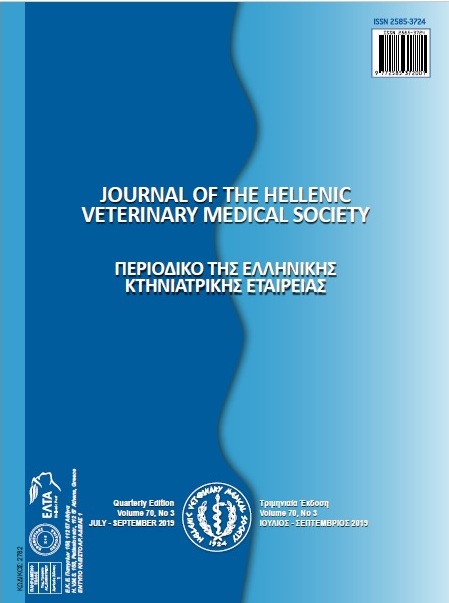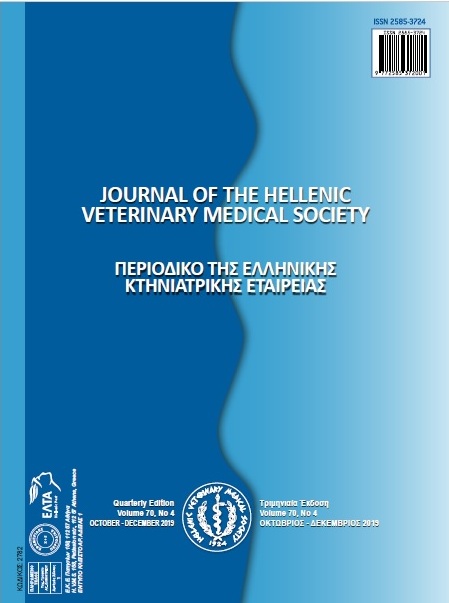The effect of progesterone on the anesthetic and analgesic requirements for ovariohysterectomy in the dog

Περίληψη
Η παρούσα μελέτη διερεύνησε την επίδραση της συγκέντρωσης της προγεστερόνης, είτε ενδογενούς κατά τον ωοθηκικό κύκλο και την κυοφορία, είτε εξωγενούς, καθώς και του ενεργού μεταβολίτη της αλλοπρεγνανολόνη, στις απαιτήσεις σε αναισθητικά και αναλγητικά φάρμακα και στην ένταση του μετεγχειρητικού πόνου για τη διεξαγωγή ωοθηκυστερεκτομής στον σκύλο. Περιελήφθησαν 150 υγιείς, θηλυκοί σκύλοι, οι οποίο προσκομίστηκαν στην Κλινική Ζώων Συντροφιάς του ΑΠΘ για ωοθηκυστερεκτομή και οι οποίοι κατανεμήθηκαν σε 6 ομάδες με βάση το στάδιο του ωοθηκικού κύκλου και την ενδεχόμενη ορμονική αγωγή που έλαβαν. Συγκεκριμένα, σχηματίστηκαν 6 ομάδες από ζώα στο στάδιο του ανοίστρου (ομάδα Α), ζώα σε άνοιστρο που έλαβαν προγεστερόνη ενδομυϊκώς (Απ), ζώα στο στάδιο του διοίστρου (Δ), ζώα σε δίοιστρο που έλαβαν υποδορίως αγλεπριστόνη (Δα), ζώα σε δίοιστρο που έλαβαν κάψουλες τριλοστάνης (Δτ) και ζώα σε κυοφορία 28-42 ημερών (Ε). Σε κάθε ζώο καταγράφηκαν οι απαιτήσεις σε προποφόλη για εγκατάσταση της γενικής αναισθησίας, οι απαιτήσεις σε ισοφλουράνιο για διατήρηση, οι απαιτήσεις σε επιπλέον αναλγητικά φάρμακα είτε διεγχειρητικά είτε μετεγχειρητικά και έγιναν μετεγχειρητικές εκτιμήσεις πόνου. Επίσης έγιναν αιμοληψίες σε συγκεκριμένες χρονικές στιγμές για ορμονολογικές αναλύσεις. Μετά τη στατιστική επεξεργασία των αποτελεσμάτων δε βρέθηκε στατιστικώς σημαντική διαφορά στις απαιτήσεις σε αναισθητικά ή σε αναλγητικά φάρμακα μεταξύ των ομάδων, ούτε στατιστικώς σημαντική συσχέτιση μεταξύ των απαιτήσεων αυτών και των συγκεντρώσεων στο αίμα της προγεστερόνης ή της αλλοπρεγνανολόνης, εκτός από 2 συσχετίσεις εντός συγκεκριμένων ομάδων. Συμπεραίνεται ότι οι συγκεντρώσεις προγεστερόνης ή αλλοπρεγνανολόνης στο αίμα δεν επηρεάζουν τις απαιτήσεις σε αναισθητικά ή αναλγητικά φάρμακα για τη διεξαγωγή ωοθηκυστερεκτομής στο σκύλο ή ότι ενδεχόμενη τέτοια επιρροή επικαλύπτεται από τη χορήγηση προαναισθητικής αγωγής και αναλγητικών φαρμάκων.
Λεπτομέρειες άρθρου
- Πώς να δημιουργήσετε Αναφορές
-
KOSTAKIS, C., ANAGNOSTOU, T., SAVVAS, I., VERVERIDIS, C., & KOURELIS, A. (2019). The effect of progesterone on the anesthetic and analgesic requirements for ovariohysterectomy in the dog. Περιοδικό της Ελληνικής Κτηνιατρικής Εταιρείας, 70(3), 1717–1726. https://doi.org/10.12681/jhvms.21798
- Τεύχος
- Τόμ. 70 Αρ. 3 (2019)
- Ενότητα
- Research Articles

Αυτή η εργασία είναι αδειοδοτημένη υπό το CC Αναφορά Δημιουργού – Μη Εμπορική Χρήση 4.0.
Οι συγγραφείς των άρθρων που δημοσιεύονται στο περιοδικό διατηρούν τα δικαιώματα πνευματικής ιδιοκτησίας επί των άρθρων τους, δίνοντας στο περιοδικό το δικαίωμα της πρώτης δημοσίευσης.
Άρθρα που δημοσιεύονται στο περιοδικό διατίθενται με άδεια Creative Commons 4.0 Non Commercial και σύμφωνα με την άδεια μπορούν να χρησιμοποιούνται ελεύθερα, με αναφορά στο/στη συγγραφέα και στην πρώτη δημοσίευση για μη κερδοσκοπικούς σκοπούς.
Οι συγγραφείς μπορούν να καταθέσουν το άρθρο σε ιδρυματικό ή άλλο αποθετήριο ή/και να το δημοσιεύσουν σε άλλη έκδοση, με υποχρεωτική την αναφορά πρώτης δημοσίευσης στο J Hellenic Vet Med Soc
Οι συγγραφείς ενθαρρύνονται να καταθέσουν σε αποθετήριο ή να δημοσιεύσουν την εργασία τους στο διαδίκτυο πριν ή κατά τη διαδικασία υποβολής και αξιολόγησής της.





